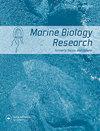Population genetics of the hound needlefish Tylosurus crocodilus (Belonidae) indicate high connectivity in Tanzanian coastal waters
IF 1.2
4区 生物学
Q4 ECOLOGY
引用次数: 0
Abstract
ABSTRACT The hound needlefish Tylosurus crocodilus (Belonidae) is a highly demanded fish in the local markets of Tanzania, but the growing coastal population threatens its sustainability. As belonids are highly migratory fishes utilising various parts of the seascape, increased fishing pressure may disrupt connectivity patterns on different spatiotemporal scales and disaggregate populations. Using the COI gene, this study assessed the genetic population structure, connectivity patterns, and historical demography of T. crocodilus collected in seven sites spread along Tanzanian coastal waters. Results showed fourteen haplotypes with low overall nucleotide and haplotype diversity. Pairwise FST comparisons revealed no significant differences among the sampled sites, except for the northernmost site (Tanga) and an island in the south (Songosongo). Analysis of molecular variance (AMOVA) revealed a non-significant genetic structure among populations (FST = 0.01782), suggesting the fishery across Tanzanian waters exploits the same population. Moreover, there was no correlative relationship between genetic and pairwise geographic distances, rejecting the isolation by distance hypothesis. However, neutrality tests and mismatch distribution analysis revealed that recent demographic expansion might exist. Empirical evidence of panmixia suggests high genetic connectivity. In combination with low genetic diversity, management should be directed to actions that prevent genetic diversity loss and the effect of genetic drift on populations.猎犬尖刺鱼Tylosurus鳄鱼(Belonidae)的种群遗传学表明坦桑尼亚沿海水域具有高度的连通性
摘要犬针鱼Tylosurus鳄鱼(Belonidae)是坦桑尼亚当地市场上需求量很大的鱼类,但沿海人口的不断增长威胁着其可持续性。由于本属动物是高度洄游的鱼类,利用海景的各个部分,捕鱼压力的增加可能会破坏不同时空尺度上的连通模式,并分解种群。利用COI基因,本研究评估了坦桑尼亚沿海水域七个地点收集的T.鳄鱼的遗传种群结构、连接模式和历史人口学。结果显示,14个单倍型具有较低的总核苷酸和单倍型多样性。成对FST比较显示,除了最北部的地点(坦加)和南部的一个岛屿(Songosongo)外,采样地点之间没有显著差异。分子变异分析(AMOVA)揭示了群体间的非显著遗传结构(FST = 0.01782),表明坦桑尼亚水域的渔业利用了相同的种群。此外,遗传距离和成对地理距离之间没有相关关系,拒绝了距离隔离假说。然而,中立性测试和不匹配分布分析表明,最近可能存在人口扩张。泛混合生殖的经验证据表明具有高度的遗传连接性。在遗传多样性低的情况下,应采取措施防止遗传多样性丧失和遗传漂移对种群的影响。
本文章由计算机程序翻译,如有差异,请以英文原文为准。
求助全文
约1分钟内获得全文
求助全文
来源期刊

Marine Biology Research
生物-海洋与淡水生物学
CiteScore
2.10
自引率
0.00%
发文量
55
审稿时长
6-12 weeks
期刊介绍:
Marine Biology Research (MBRJ) provides a worldwide forum for key information, ideas and discussion on all areas of marine biology and biological oceanography. Founded in 2005 as a merger of two Scandinavian journals, Sarsia and Ophelia, MBRJ is based today at the Institute of Marine Research, Bergen, Norway. The Journal’s scope encompasses basic and applied research from all oceans and marine habitats and on all marine organisms, the main criterium for acceptance being quality.
 求助内容:
求助内容: 应助结果提醒方式:
应助结果提醒方式:


